Introduction:
Glass, ever since it was first crafted around 500 BC, has fascinated humans. Glass has come a long way since it was once believed to have magical abilities. It’s been around for quite some time and is still used because of how adaptable and long-lasting it is. With the advent of modern architecture at the turn of the 20th century, cities became urban factories where concrete, glass, and steel were mass-produced. This philosophy was useful in meeting the demand for homes among the expanding middle class. Buildings made of glass and steel have come to represent progress in many countries because of the positive connotations that its inhabitants associate with wealth and luxury.
What is Glass?
Glass is the oldest and the most elegant material used in construction and other fields. In most cases, glass is used because it improves the aesthetic value of the building. Ever since it was first discovered, people have found glass to be an intriguing substance. Glass is a tough, see-through substance. Glass is made by heating inorganic materials like quartz or sand. When creating a striking visual effect and a novel interior layout, Glass is the material of choice for many architects. When it comes to building materials, glass is unparalleled in its adaptability.
Properties of Glass:
i) Transparency:
The main property of glass that lets you see through it is that it is clear. Glass can be clear from either sides or only one. On the other side, the transparent glass acts like a mirror.
ii) Strength:
Glass is a brittle material, but with the help of science and technology, certain laminates and admixtures can increase its modulus of rupture (ability to resist deformation under load).
iii) U Value:
U value shows how much heat goes through a piece of glass. If a glass is said to be insulated, then it should have a lower u value.
iv) Workability:
It can be used in a lot of different ways. You can blow it, draw it, or press it. There are different kinds of glass, such as clear, colorless, diffused, and stained. Fusion can also be used to join glass.
v) Transmittance:
In glass, visible transmittance refers to the amount of visible light that makes it through.
vi) Recyclable:
Cullets (scraps of shattered or discarded glass gathered for re-melting) are utilized as raw materials in the glass manufacturing process, as aggregates in a concrete building, etc.
Different Types of Glass Used in Construction:
1. Float Glass:
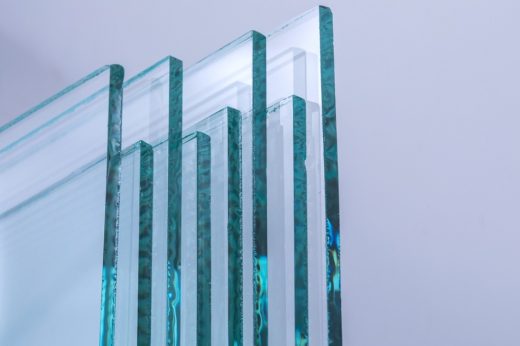
Fig 1: Float Glass
Courtesy: azom.com
Float glass is another popular type of glass that is often used in buildings. Sodium silicate and calcium silicate are the two main ingredients in float glass. soda-lime glass is another name for this type of glass. The float glass is called “float” because when it is made, molten glass floats on a bed of molten tin.
This process makes glass smooth, clean, flat, and free of distortions. Float glass does not need to be cut with any special tools. This type of glass comes in thicknesses ranging from 2 mm to 20 mm. Float glass weighs between 6 kg and 36 kg. This type of glass is placed in window openings, in front of shops, and in public places.
2. Laminated Glass:
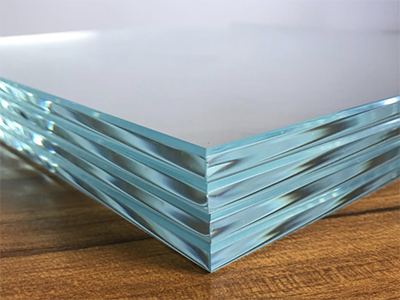
Fig 2: Float Glass
Courtesy: elitesafetyglass.com
As the name suggests, this glass comprises layers of regular glass that are stuck together by a clear, flexible material as it is a sandwich made of two or more sheets of glass. This type of glass is often resistant to UV light and noise, which is why it is used to build bridges and aquariums. It is usually best for making glass canopies because it can block harmful rays. This glass is made of two sheets of toughened glass and a laminate in the middle. It is usually 6mm hardened, 2.28mm laminated, and 6mm hardened.
3. Sheet or Flat Glass:
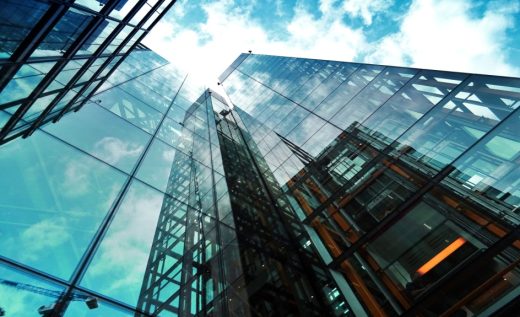
Fig 3: Flat Glass
Courtesy: info.glass.com
Sheet glass is made by running molten glass through rollers to make an almost flat finish. Sheet glass can be cut with a glass cutter; you don’t need other tools. It usually comes in a range of standard sizes and thicknesses on the market. Due to the low cost of this glass and the fact that it doesn’t distort the view, it is mostly used to cover greenhouses and other places where distortion of the view isn’t a problem.
4. Shatterproof Glass:
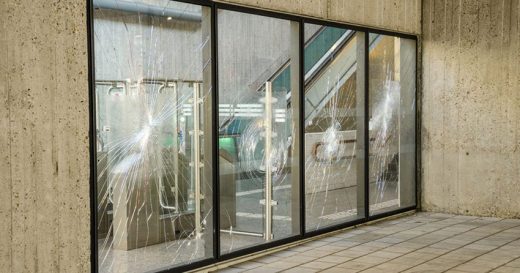
Fig 4: Shatterproof Glass
Courtesy: defenselite.com
Laminated glass is used to make shatterproof glass. Two or more sheets of glass are stuck together with an invisible layer of polyvinyl or resin, although other materials are sometimes used. The shatterproof glass between the layers of regular glass helps to cut down on sound transfer, making your home much quieter. This type of glass also cuts down on UV rays, which prevents the sun from fading fabrics and furniture.
5. Energy-efficient Glass:
Energy-efficient glass is made by applying a thin coating to one side of float glass during manufacturing. Low-emissivity coated glass is used in energy-efficient glazing to reduce heat loss. The increased energy efficiency of your structure is a direct result of the windows’ superior thermal insulation.
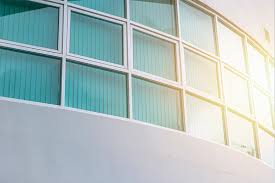
Fig 5: Energy-efficient Glass
Courtesy: glasxperts.com
6. Tinted Glass:
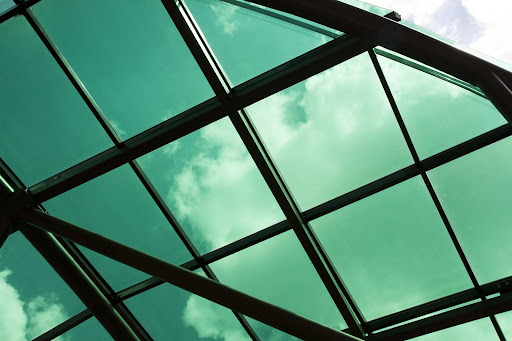
Fig 6: Tinted Glass
Courtesy: aisglass.com
Tinted glass is a well-known and popular type of glass that is used a lot all over the world. Tinted glass is just colored glass that is mostly used in buildings. To get the different colors in tinted glass, we add a special type of iron to the glass mix when we’re making it. The best thing about this glass is that it looks very pretty and colorful, but the color still needs to change how it works. Windows, roofs, and other places have tinted glass. When the tinted glass was made, iron oxide was added to make it green, and sulfur was added to make it blue.
7. Toughened Glass:
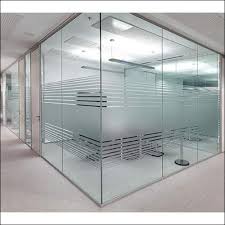
Fig 7: Toughened Glass
Courtesy: aryaaluminium.com
Toughened glass, often known as safety glass or tempered glass, is widely used due to its durability and invulnerability to breakage. It is designed to shatter into smaller, “safer” bits rather than massive shards (like float glass). Toughened glass is commonly utilized in the interior of homes for applications including kitchen countertops (due to its heat resistance), shower enclosures, glass railings, and pool fencing. If additional safeguards are required, they can also be used in laminated panels.
8. Weird Glass:
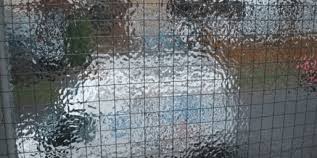
Fig 8: Weird Glass
Courtesy: allpurposeglazing.com
Wire-framed glass has been used for decades, and it keeps the glass from breaking in an emergency. When the glass is made, wire mesh is used to strengthen it. It makes it more durable and resistant to fire than float glass. It is also called Georgian wired glass, and wire mesh works as reinforcement. The wire holds it in place if something with a higher impact breaks the glass. It lowers the chances of anyone getting hurt. The wire mesh glass comes with both diamond and square grids.
9. Chromatic Glass:
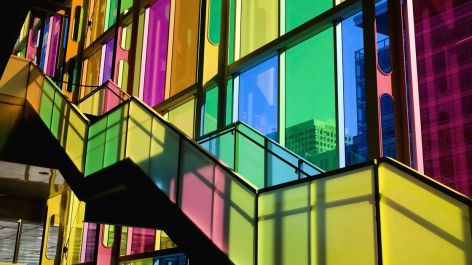
Fig 9: Chromatic Glass
Courtesy: allpurposeglazing.com
Chromatic glass is a special type of Glass that is used in ICUs and meeting rooms. Chromatic Glass has a special property that protects the inside from light. This kind of glass is more expensive than others. Electric lamination might sometimes happen on chromatic glass (electro-chromatic). Chromatic glass also comes in thermo-chromatic (heat-sensitive lamination) and photo chromic varieties (has light-sensitive lamination).
10. Self Cleaning Glass:
Self-cleaning glass is a special kind of glass whose surface doesn’t get dirty easily. There are two types of self-cleaning coatings for glass: hydrophobic and hydrophilic. Both of these types of coating clean themselves with the help of water. The first type cleans itself with rolling water droplets, and the second cleans itself with sheets of water carrying away dirt. Titania (titanium dioxide)-based hydrophilic coatings, on the other hand, has an extra property: they can chemically break down dirt when exposed to sunlight.
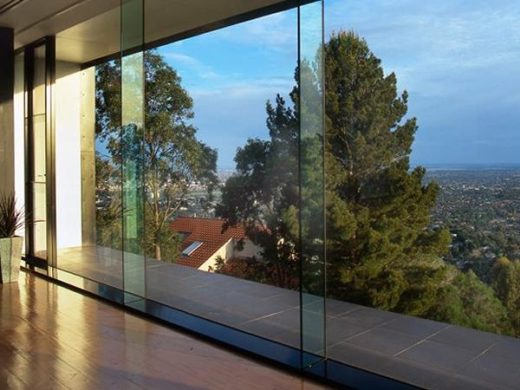
Fig 10: Self Cleaning Glass
Courtesy: glassonweb.com
11. Glass Block:
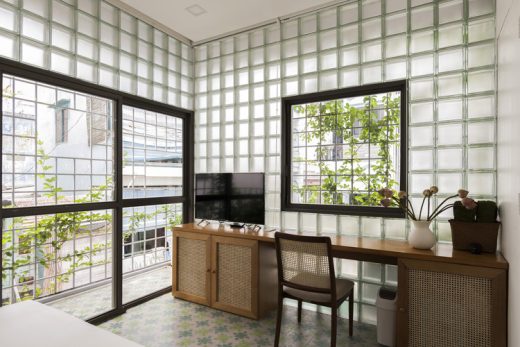
Fig 10: Glass Block
Courtesy: archdaily.com
Glass block is a popular and well-known material. There are two different kinds of glass blocks. One is solid, and the other is hollow. Most glass blocks are made of two separate pieces. When the Glass is still hot, the two pieces are pressed together. Some of the vacuums are still there in the part where they join. Most of the time, hollow glass wall blocks let light inside a building. The price is also high because the glass blocks have to be put in by very skilled workers.
Advantages of Glass:
- Glass is a special kind of transparent material that lets light travel through it, allowing a clear view of what’s on the other side. So, it saves energy and lowers the cost of electricity.
- The glass comes in a wide range of colors, and when the sheets are put together in laminated or insulated units, the colors change and make the look more beautiful.
- Since glass is shiny and smooth, it is sealed off from dust and is easy to wipe down. It requires less upkeep than other materials. Glass’s twin properties as a dustproof and waterproof material make it a popular choice in regions where the air is frequently laden with dust and sand.
- Glass is a material that may be recycled indefinitely without losing quality. It can be recycled multiple times without losing its original integrity or quality.
- Glass provides a visually superior display option for products. The glassy effect it can produce can greatly enhance the building’s visual appeal.
- Glass is UV stable because it doesn’t react to ultraviolet radiation, so that it won’t crack, fade, or fall apart.
- Glass can handle any weather. It can stand up better to the effects of wind, rain, or the sun and keep its shape and look in most conditions.
- Glass for the building is a clear, hard material that can easily shape into any shape you want. It is made by heating sand.
- The Glass used in buildings is a great insulator. It doesn’t easily let electricity flow through it. It keeps you from getting hurt by any electrical hazards.
Disadvantages of Glass:
- Glass production is expensive since it requires a high temperature for processing. Because glass is transparent, it raises the overall cost of the structure while also reducing privacy.
- The glass has little capacity to endure an instantly imposed load since it is less impact resistant. Under force, it will quickly crack.
- Due to the rigidity and stiffness of glass, adding weights will cause it to break without exerting much effort. The shattered glass fragment is extremely damaging and deadly.
- To withstand horizontal stresses and motions, structures built in earthquake-prone regions must be specifically engineered. Glass is a substance that is more prone to breaking or collapsing fast because it is more fragile than other materials.
- A glass surface becomes diluted by an alkali solution, and if there is a constant supply of alkali, this corrosion will occur.
- Dust particles adhere to the glass in dusty and humid environments, making upkeep particularly challenging.
Conclusion:
Glass is utilized in the building envelope as a transparent glazing component. It applies to interior and exterior partitions, as well as windows. Glass, like other construction materials, comes in various designs and colors. Security, beauty, privacy, and insulation glass all serve different purposes and appearances. Changing their manufacturing procedures may boost their strength, vary their hues, and even make them less likely to shatter.
References:
1. “Types of Glass Used in Construction | Properties of Glass.” Types of Glass Used in Construction | Properties of Glass, www.constructioncost.co/types-of-glass-used-in-construction.html. Accessed 16 Jan. 2023.
2. “Glass as a Building Material.” Understand Building Construction,
www.understandconstruction.com/glass.html. Accessed 16 Jan. 2023.
3. “Different Types of Glass Used in Buildings and Structures.” Constro Facilitator, 30 Sept. 2022, constrofacilitator.com/different-types-of-glass-used-in-buildings-and-structures.
4. “The Different Types of Glass Used in Construction.” EBOSS, 25 May 2020, www.eboss.co.nz/detailed/metro-technical/different-types-of-glass-structural-construction-use.
5. BuilderSpace. “10 Types of Glass Used in Construction – BuilderSpace.” BuilderSpace, 7 Jan. 2021, www.builderspace.com/types-of-glass-used-in-construction.
6. “Glass Properties Types Material Performances and Uses in Construction – Blog – the Design Bridge.” Glass Properties Types Material Performances and Uses in Construction – Blog – the Design Bridge,
thedesignbridge.in/blog/glass-properties-types-material-performances-and-uses-in-construction. Accessed 16 Jan. 2023.
If you have a query, you can ask a question here.


